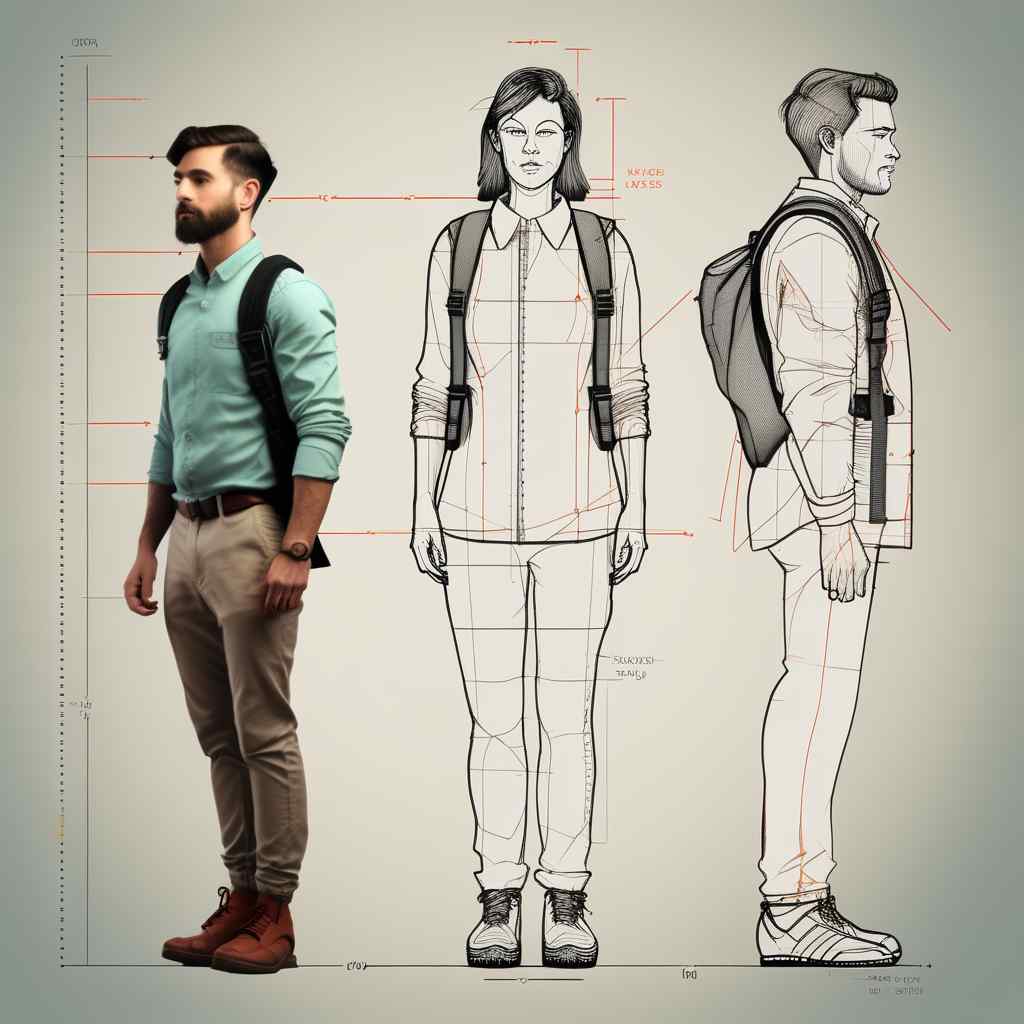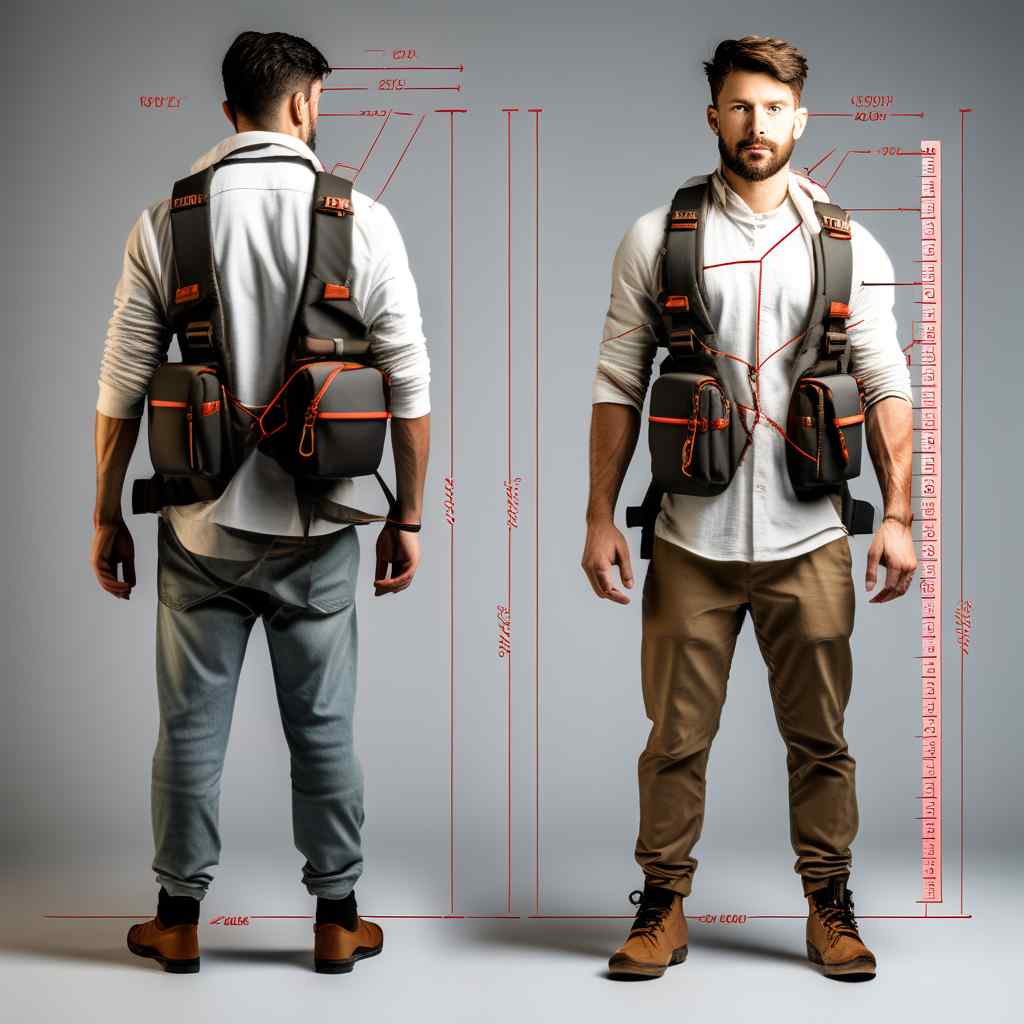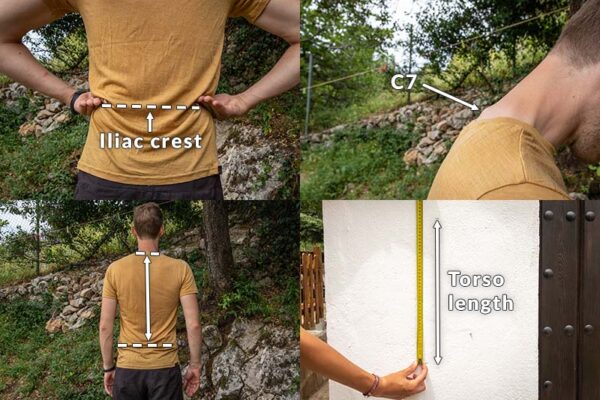When it comes to backpacking, having the right size backpack is crucial. A properly fitting backpack not only ensures your comfort but also contributes to stability and reduces the risk of injuries. One of the key factors in determining the right backpack size is your torso length. Abbybags will guide you through the process of measuring your torso length and help you find the perfect backpack fit. So, let’s dive in and explore how you can measure your torso length accurately.
Torso Length
Before we jump into the measurement process, let’s clarify what torso length actually means. Your torso length refers to the distance between your seventh cervical vertebra (often referred to as C7) and the imaginary line drawn between your thumbs when you place your hands on your hips. It is an essential measurement for finding a backpack that fits well and provides optimal support during your backpacking adventures.

Measuring Torso Length
To measure your torso length accurately, follow these simple steps:
- Stand up straight and maintain a natural posture.
- Place your hands on your hips, with your thumbs pointing backward.
- Draw an imaginary line between your thumbs, creating a reference line.
- Tilt your head slightly forward and feel for the bony bump at the base of your neck.
- This bony bump is your seventh cervical vertebra (C7).
- Using a flexible tape measure, measure the distance between your C7 and the imaginary line between your thumbs.
- Make sure the tape measure follows the natural curve of your spine for an accurate measurement.
Remember, it’s essential to have someone else help you with the measurement to ensure accuracy. Having a friend measure your torso length will help you get the most precise results.
Using the Measurement to Determine Backpack Size
Once you have measured your torso length, you can use this measurement to determine the appropriate backpack size. Backpack sizes are typically categorized based on torso length ranges. Manufacturers provide sizing charts that match torso length to specific backpack sizes. It’s important to refer to these charts to find the best fit for your measurements.
Keep in mind that a backpack’s fit is not solely determined by torso length. Other factors, such as shoulder straps and hip belts, also play a crucial role in achieving a comfortable and stable fit. It’s recommended to seek expert advice and consider the recommendations from reputable outdoor retailers like REI.
Expert Advice from REI
REI, a well-known outdoor retailer, provides valuable insights when it comes to backpacking gear. Their backpacking experts recommend considering various factors when choosing a backpack size, including your torso length, the load you plan to carry, and the type of backpacking trip you’ll embark on. Taking these factors into account will help you select a backpack that suits your specific needs and preferences.
Backpack Fit
To better understand backpack fit, let’s explore the components of a backpack that affect how it sits on your body. The shoulder straps and hip belt are two critical elements that contribute to the overall fit and comfort of a backpack.
The shoulder straps help distribute the weight of the pack across your shoulders and upper back. They should be adjusted to comfortably wrap around your shoulders without digging into your skin. The hip belt, on the other hand, transfers the weight of the pack from your shoulders to your hips. It should sit snugly on your hip bones (iliac crest) and be adjusted to provide proper support.
Adjusting the Backpack for a Proper Fit
Once you have determined the rightbackpack size based on your torso length, it’s important to know how to adjust the backpack for a proper fit. Follow these steps to ensure your backpack fits comfortably:
- Start by tightening the shoulder straps. Pull them snugly, but not too tight, to distribute the weight evenly across your shoulders and upper back. Avoid excessive pressure on your shoulders by adjusting the straps accordingly.
- Adjust the hip belt next. Place your hands on your hips, and slide them down until you feel the top of your hip bones (iliac crest). The hip belt should sit just above your hip bones, with the padding resting comfortably on your hips. Tighten the belt until it feels snug, but not overly tight.
- Fine-tune the fit by adjusting the load lifter straps and sternum strap. The load lifter straps connect the top of the shoulder harness to the backpack and help balance the weight distribution. Adjust them to a 45-degree angle for optimal load distribution. The sternum strap, which connects the shoulder straps, should be positioned at a comfortable height and tightened to prevent the shoulder straps from slipping.
Remember, finding the right backpack fit may require some trial and error. Take your time to adjust the various components until the backpack feels secure and comfortable on your body.

Sizing Charts and Guidelines
Many backpack manufacturers provide sizing charts that correlate torso length with specific backpack sizes. These charts can be incredibly helpful in finding the right fit. When using a sizing chart, locate your torso length measurement and match it with the corresponding backpack size. Some charts may also include additional guidelines based on waist size or other factors.
It’s important to note that these sizing charts serve as general guidelines, and personal preferences may vary. Ultimately, the best fit is the one that feels most comfortable and stable for you. Don’t hesitate to try on different backpack sizes and models to find the one that suits you best.
Finding the Right Backpack for Your Torso Length
Now that you have a clear understanding of how to measure your torso length and determine the right backpack size, it’s time to explore the options available. Various backpack models cater to different torso lengths and types of backpacking trips.
Consider your backpacking needs and preferences. Are you planning a short weekend trip or a long-distance trek? Do you prioritize ultralight gear or are you carrying heavier loads? Understanding your requirements will guide you in selecting the most suitable backpack for your adventures.
Reputable outdoor retailers, including REI, offer a wide range of backpack options for different torso lengths. Their knowledgeable staff can provide expert advice and help you find the best fit based on your measurements and specific needs. Don’t hesitate to reach out to them for guidance and recommendations.

Essential Factors for Fitting and Sizing Backpacks Perfectly
When it comes to finding the perfect fit for your backpacking pack, several essential factors should be considered. These factors include the hipbelt, torso measurement, head forward position, torso ranges for each pack size, hipbelt size, shoulder straps and hipbelt, pack’s suspension system, center of gravity, pressure points, and buckle and tighten techniques. Let’s explore these factors in more detail.
1. Hipbelt: The hipbelt plays a crucial role in transferring the weight from your shoulders to your hips. It should sit comfortably on your hips rather than your waist. The hipbelt should be adjustable and have adequate padding to provide proper support and distribute the weight evenly.
2. Torso Measurement: Measuring your torso size accurately is essential for finding the right backpack size. Measure the distance between the 7th cervical vertebra (C7) and the top of your hipbone (iliac crest) to determine your torso length.
3. Head Forward and Feel: When measuring your torso length, tilt your head slightly forward and feel for the bony bump at the base of your neck. This bony bump is your 7th cervical vertebra (C7), which serves as a reference point for measuring your torso length.
4. Torso Ranges for Each Pack Size: Backpack manufacturers provide torso length ranges for each pack size. These ranges help you match your torso measurement with the appropriate backpack size. Choose a pack size that falls within your torso length range for the best fit.
5. Shoulder Straps and Hipbelt: The shoulder straps and hipbelt are key components of a backpack’s suspension system. Properly adjusting these elements ensures comfort and stability. The shoulder straps should wrap around your shoulders without digging in, and the hipbelt should snugly fit on your hips.
6. Center of Gravity: A well-fitting backpack should position the center of gravity close to your body, aligning with your natural balance. This helps maintain stability and reduces strain on your back. Adjust the pack’s suspension system to achieve the proper center of gravity.
7. Pressure Points: Pay attention to pressure points that may develop during the fitting process. If you experience discomfort or pressure in specific areas, such as the shoulders or hips, adjust the shoulder straps, hipbelt, or padding to alleviate any pressure points.
8. Buckle and Tighten Techniques: Once you have adjusted the shoulder straps and hipbelt, buckle and tighten them properly. This step ensures a secure fit and prevents the pack from shifting during your backpacking adventures.
Tips for Achieving Comfortable and Secure Torso Length Adjustment
When it comes to backpacking, having a properly fitted backpack is essential for a comfortable and secure experience on the trails. One crucial aspect of achieving a good fit is adjusting the torso length of your backpack. By following these tips and utilizing a sizing guide, you can ensure that your torso length is fine-tuned to provide optimal support and comfort during your adventures.
Understand Torso Length: The torso length refers to the distance between the C7 vertebra (the prominent bone at the base of your neck) and the top of your hip measurement. It’s important to measure your torso length accurately before adjusting your backpack.
Find the Right Backpack: Different backpacks come in various sizes and designs to accommodate different torso lengths. Look for a backpack with an interchangeable hip belt and adjustable shoulder straps to customize the fit according to your torso length.
Use a Sizing Guide: Many backpack manufacturers provide sizing guides on their websites or in-store. These guides help you determine the appropriate torso length range for each backpack size they offer. Refer to the sizing guide to narrow down your options.
Adjust the Shoulder Straps: Once you’ve selected a backpack that matches your torso length, put it on and adjust the shoulder straps. Start by loosening them completely, then slide your hands into the shoulder straps from the bottom of the pack. Lift the pack and position it on your back, ensuring that the shoulder straps rest comfortably on your shoulders.
Align the C7 Vertebra: To properly adjust the torso length, bend your head forward slightly and locate the C7 vertebra. It should be the highest point on your back, sticking out slightly. Make sure the shoulder straps align with the C7 vertebra, as this will provide the best support and weight distribution.
Fine-Tune the Fit: After aligning the C7 vertebra with the shoulder straps, tighten them gradually until the pack feels snug but not overly tight. Avoid having excess space between your shoulders and the shoulder straps. Properly adjusted shoulder straps will prevent the pack from pulling backward or sagging downward.
Check the Lumbar Region: The lumbar region is the curve in the lower part of your back. Ensure that the pack rests comfortably against your back and follows the natural contour of your lumbar region. If needed, adjust the hip belt to achieve a secure fit around your hips and distribute the weight evenly.
Evaluate Comfort and Security: Walk around with the adjusted backpack to assess how it feels. It should provide a balanced load without causing discomfort or pain. Keep the shoulder straps snug but not too tight, and check that the belt padding rests comfortably on your hip bones. If any adjustments are required, make them until the pack feels best for you.
Test in the Backcountry: Before embarking on a long hike or backpacking trip, take a short test hike with your fully loaded pack. This will give you a chance to evaluate the fit and make any necessary adjustments before committing to a longer expedition.
Conclusion
Choosing the right backpack size based on your torso length is crucial for a comfortable and enjoyable backpacking experience. By following the steps outlined in this article, you can accurately measure your torso length and find the backpack that fits you perfectly. Remember to consider other factors such as shoulder straps and hip belts when assessing the overall fit. Expert advice from reputable outdoor retailers like REI can also provide valuable insights. So, measure your torso length, find the right backpack size, and embark on your next adventure with confidence!
FAQs (How Do you Measure Torso Length for a Backpack)
Q: Can I measure my torso length by myself?
A: While it’s possible to measure your torso length by yourself, it’s recommended to have someone else help for more accurate results. A friend can ensure the tape measure is properly aligned and provide assistance during the measurement process.
Q: Can I use a regular measuring tape to measure my torso length?
A: Yes, a flexible measuring tape is suitable for measuring your torso length. Make sure the tape measure follows the natural curve of your spine for an accurate measurement.
Q: Should I consider other factors besides torso length when choosing a backpack size?
A: Absolutely! In addition to torso length, factors such as load capacity, backpack type, and personal preferences should be taken into account when selecting a backpack size.
Q: How do I know if a backpack fits me properly?
A: A properly fitting backpack should distribute the weight evenly across your shoulders and hips. It should feel snug but not overly tight, with the shoulder straps and hip belt adjusted to your comfort.
Q: Can I adjust the backpack myself if it doesn’t fit correctly?
A: Yes, you can adjust the shoulder straps, hip belt, load lifter straps, and sternum strap to achieve a proper fit. If you’re unsure how to make the adjustments, seek guidance from an experienced backpacking expert or refer to the manufacturer’s instructions.
Ameer Hamza is a dedicated fashion writer with a keen eye for emerging trends and a passion for the artistry of style. His work delves into the latest in fashion, offering readers insights on everything from runway-inspired looks to everyday elegance. With a flair for storytelling and a deep understanding of the industry, Ameer Hamza brings a fresh perspective, making high fashion accessible and inspiring to all. Follow along as he explores the intersection of creativity, culture, and couture in the ever-evolving world of fashion.
